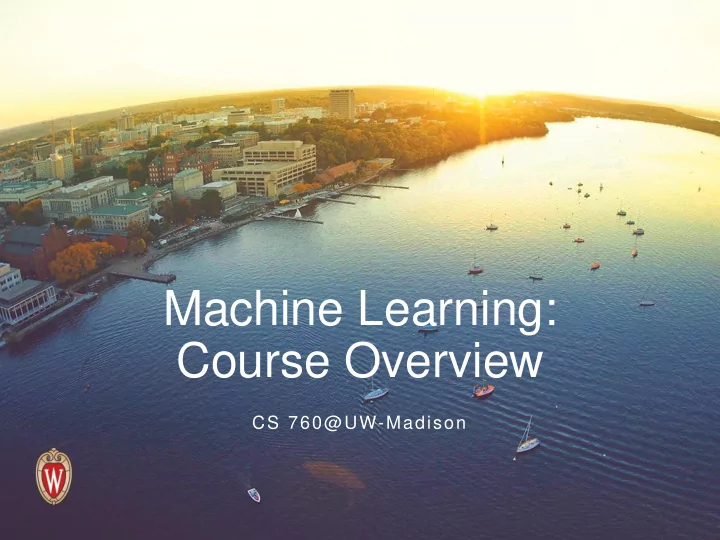

Machine Learning: Course Overview CS 760@UW-Madison
Class enrollment • typically the class was limited to 30 • we’ve allowed ~100 to register • the waiting list full • unfortunately, many on the waiting list will not be able to enroll • but CS760 will be offered in the next semester!
Instructor • Yingyu Liang email: yliang@cs.wisc.edu office hours: Mon 4-5pm office: 6393 Computer Sciences
TA • Ying Fan email: yingfan@cs.wisc.edu office hours: Tues 1-2pm, Thu 1-2pm office: CS 1351
Monday, Wednesday and Friday? • we’ll have ~30 lectures in all, just like a standard TR class • will push the lectures forward (finish early, leave time for projects and review) • see the schedule on the course website: http://pages.cs.wisc.edu/~yliang/cs760_spring20
Course emphases • a variety of learning settings: supervised learning, unsupervised learning, reinforcement learning, active learning, etc. • a broad toolbox of machine-learning methods: decision trees, nearest neighbor, neural nets, Bayesian networks, SVMs, etc. • some underlying theory: bias-variance tradeoff, PAC learning, mistake-bound theory, etc. • experimental methodology for evaluating learning systems: cross validation, ROC and PR curves, hypothesis testing, etc.
Two major goals 1. Understand what a learning system should do 2. Understand how (and how well) existing systems work
Course requirements • 7-8 homework assignments: 30% • programming • computational experiments (e.g. measure the effect of varying parameter x in algorithm y ) • some written exercises • Midterm Exam #1: 20% • Midterm Exam #2: 20% • final project: 30% • project group: 3-5 people
Expected background • CS 540 (Intro to Artificial Intelligence) or equivalent • good programming skills • probability • linear algebra • calculus, including partial derivatives
Programming languages • for the programming assignments, you can use C C++ Java Perl Python R Matlab • suggest: Python • programs must be callable from the command line and must run on the CS lab machines (this is where they will be tested during grading!)
Course readings Recommend to get one of the following books • Pattern Recognition and Machine Learning. C. Bishop . Springer, 2011. • Machine Learning: A Probabilistic Perspective . K. Murphy. MIT Press, 2012. • Understanding Machine Learning: From Theory to Algorithms. S. Shalev-Shwartz, S. Ben-David. Cambridge University press, 2014.
Course readings • the books can be found online or at Wendt Commons Library • additional readings will come from online articles, surveys, and chapters • will be posted on course website
Machine Learning Examples
What is machine learning? • “A computer program is said to learn from experience E with respect to some class of tasks T and performance measure P, if its performance at tasks in T as measured by P, improves with experience E.” ------- Machine Learning , Tom Mitchell, 1997 learning
What is machine learning? • the study of algorithms that improve their performance P at some task T with experience E • to have a well-defined learning task, we must specify: < P, T, E >
ML example: image classification indoor outdoor
ML example: image classification • T : given new images, classify as indoor vs. outdoor • P : minimize misclassification costs • E : given images with indoor/outdoor labels
ML example: spam filtering
ML example: spam filtering • T : given new mail message, classify as spam vs. other • P : minimize misclassification costs • E : previously classified (filed) messages
ML example: predictive text input
ML example: predictive text input • T : given (partially) typed word, predict the word the user intended to type • P : minimize misclassifications • E : words previously typed by the user (+ lexicon of common words + knowledge of keyboard layout) domain knowledge
ML example: Netflix Prize
ML example: Netflix Prize • T : given a user/movie pair, predict the user’s rating (1 -5 stars) of the movie • P : minimize difference between predicted and actual rating • E : histories of previously rated movies (user/movie/rating triples)
ML example: autonomous helicopter video of Stanford University autonomous helicopter from http://heli.stanford.edu/
ML example: autonomous helicopter • T : given a measurement of the helicopter’s current state (orientation sensor, GPS, cameras), select an adjustment of the controls • P : maximize reward (intended trajectory + penalty function) • E : state, action and reward triples from previous demonstration flights
ML example: Atari Breakout Google DeepMind's Deep Q-learning playing Atari Breakout From the paper “Playing Atari with Deep Reinforcement Learning”, by Volodymyr Mnih, Koray Kavukcuoglu, David Silver, Alex Graves, Ioannis Antonoglou, Daan Wierstra, Martin Riedmiller
ML example: AlphaGo
Assignments
Reading assignment • read • Chapter 1 of Murphy • article by Jordan and Mitchell on course website • course website: http://pages.cs.wisc.edu/~yliang/cs760_spring20/
HW1: Background test • posted on course website • will set up how to submit the solutions on Canvas • Two parts: minimum and medium tests • if pass both: in good shape • if pass minimum but not medium: can still take but expect to fill in background • if fail both: suggest to fill in background before taking the course
Minimum background test • 80 pts in total; pass: 48pts • linear algebra: 20 pts • probability: 20 pts • calculus: 20 pts • big-O notations: 20 pts
Minimum test example
Minimum test example
Medium background test • 20 pts in total; pass: 12 pts • algorithm: 5 pts • probability: 5 pts • linear algebra: 5 pts • programming: 5 pts
Medium test example
Medium test example
THANK YOU Some of the slides in these lectures have been adapted/borrowed from materials developed by Mark Craven, David Page, Jude Shavlik, Tom Mitchell, Nina Balcan, Elad Hazan, Tom Dietterich, and Pedro Domingos.
Recommend
More recommend